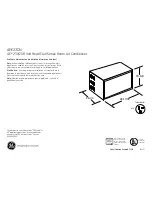
Manual 2100-738C
Page
43 of 73
DEHUMIDIFICATION
Model Features
These models provide a unique dehumidification
circuit for periods of high indoor humidity conditions.
Additionally, an “energy recovery ventilator” may be
provided to allow for outside ventilation air requirements
by eliminating excessive sensible and latent loads as a
result of the increased ventilation requirement.
Refer to Specification Sheet S3601 for the standard
features of the QW*S3D models. Electrical data for
the QW dehumidification Q-TEC models is unique and
cannot be directly compared to the electrical data for
the standard Q-TEC models.
Special Features
Dehumidification Circuit
There are two events taking place to maximize the
dehumidification performance while the unit is in
dehumidification. The first event integrates a 3-way water
valve with the iSeries Smart Actuator monitoring the
supply air temperature. The second event incorporates a
refrigeration dehumidification circuit, which includes an
independent heat exchanger coil in the supply air stream
in addition to the standard evaporator coil.
The first event, featuring the 3-way water valve with
the iSeries Smart Actuator, monitors the supply air
temperature with a thermistor. The iSeries Smart
Actuator has a temperature setting adjustment located at
the top of the actuator (see Figure 33). The temperature
setting adjustment scans the temperature communicated
to the modulating water line control from the thermistor
located in the indoor blower supply air stream. The ohm
reading is sent to the iSeries Smart Actuator, attached to
the 3-way water valve, that will drive the valve closed or
open depending on the requirement for heat exchange.
To attain the required setting, an initial adjustment
will be required by the service technician at set-up.
The adjustment will allow for fine tuning the demand
for latent extraction. The factory setting for the iSeries
Smart Actuator should be just above the 80°F setting
indicated on the setting control.
The second event incorporating the refrigeration
dehumidification circuit uses a coil to reheat the
supply air after it passes over the cooling coil, and
is sized to nominally match the sensible cooling
capacity of the evaporator coil. Extended run times in
dehumidification mode can be achieved using waste
heat from the refrigeration cycle to achieve the reheat
process, while at the same time large amounts of
moisture can be extracted from the passing air stream.
See
Dehumidification Sequence of Operation
for
specific operating sequences and review the tables for
performance on sensible and latent capacities, water
removal ratings and supply air delivery conditions.
The dehumidification refrigerant reheat circuit is
controlled by a 3-way valve in the refrigeration
circuit, directing the refrigerant gas to the normal
water condenser during periods when standard air
conditioning is required. During periods of time of low
ambient temperature (approximately 65°F to 75°F
outdoor) and high indoor humidity, a humidistat senses
the need for mechanical dehumidification. It then
energizes both the compressor circuit and the 3-way
valve, thus directing the hot refrigerant discharge gas
into a separate desuperheating condenser circuit which
reheats the conditioned air before it is delivered to
the room. The refrigerant gas is then routed from the
desuperheating condenser to the water coil for further
heat transfer. When the humidistat is satisfied, the
system automatically switches back to normal A/C
mode and either continues to operate or turns off based
on the signal from the wall thermostat. The result is
separate humidity control at minimum operating cost.
Dehumidification Sequence of Operation
Dehumidification is controlled through a humidistat
and is independent of the thermostat. On a call for
dehumidification mode of operation, the compressor
will operate at full load (capacity) and 3-way valve that
feeds the reheat coil is energized through D terminal.
Dehumidification will continue until the humidistat is
satisfied.
Anytime there is a R-Y call for cooling or heat pump
during an active D call, the system will undergo a
time delay sequence. The sequence will incorporate
a 75-second time delay before the YO signal will
become active and a 55-second time OFF delay on
the D call. After the time delays have been satisfied,
dehumidification is canceled.
The time delay allows the modulating water valve to
open, allowing full capacity water flow to be achieved
before cooling is initialized. The unit will then operate
in the cooling mode at part load for Stage 1 cooling
(can shift to full load if 2nd Stage cooling is required)
until thermostat is satisfied. If dehumidification call
is still present when cooling call is satisfied, the unit
will continue to operate and immediately revert to
dehumidification mode, with compressor at full level.
FIGURE 33
iSeries Smart Actuator Temperature Adjustment
MIS-4136 A
















































